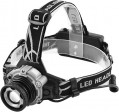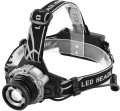Model of the LED(s) used in the flashlight. Knowing the exact name of the LED, you can find its detailed characteristics and evaluate the capabilities of the flashlight. In addition, this information may be useful when replacing a failed diode.
Note that the LED model is indicated mainly if it is a high-quality LED with advanced characteristics. Such light sources are produced by different manufacturers, but the most popular in modern flashlights are products from Cree with its series
Cree XM,
Cree XP,
Cree XHP. Here are some of the most common LEDs from this brand:
Cree XP-L,
Cree XM-L2,
Cree XP-E,
Cree XP-G,
Cree XM-L T6,
Cree XM-L2 T6,
Cree XM-L U2,
Cree XM- L2 U2,
Cree XP-G R5,
Cree XP-G2 R5,
Cree XP-E Q5.
Cree XM-L and XM-L2 series diodes are used in high-power flashlights. XP-G and XP-G2 are used in relatively small models. They produce a beam of light in the shape of a circle with a darkening inside when using a reflector to focus. XP-E and XP-E2 are a godsend for small items with an evenly f
...ocused beam and even illumination on the sides. The number “2” in the designation of the diode model indicates increased brightness (compared to the basic modification). The XHP series is also gaining popularity - the LEDs in this line more than double the light flow. At the same time, they are compatible with standard printed circuit boards and optics. The numerical prefix 35/50/70 in the name of XHP diodes indicates the dimensions of the housing.
A separate case is represented by diode plates made using COB technology (chip-on-board, that is, “chip on a board”). Such plates are arrays of a large number of miniature light sources, soldered directly into a printed circuit board at a short distance from each other and filled with a special composition; This composition performs two functions at once. First of all, it protects the LEDs from contact with air, which increases their service life; In addition, the coating effectively diffuses light, creating a uniform luminous flux.
Note that previously, to create LED arrays, SMD technology was mainly used, with individual LEDs soldered onto the surface of a printed circuit board. However, COB is a more modern and more advanced option: this technology allows small but bright light sources to be placed at very high densities, achieving powerful lumen output even with small array sizes. In addition, SMD boards did not provide a protective coating.
In general, it makes sense to pay attention to flashlights with COB plates if you need a high-quality source of diffused light. As a result, such diode arrays are especially popular in travel lanterns and auxiliary lighting (see "Type"), but can also be used in other varieties - from ultra-compact key fobs to high-power hand-held lamps.The ability to control the flashlight "from a distance", usually with hand gestures.
This function is found mainly in headlamp models (see "Type") — it is in such lamps that it is most justified, taking into account the specifics of the application. The IR sensor in the front of the case is usually responsible for
contactless control : by waving your hand in front of it, you can turn the flashlight on and off. It is faster, more convenient, and often safer than looking for a switch on the case. In this case, the sensor is configured in such a way as to prevent false positives as much as possible (for example, when approaching an obstacle). And models with several brightness modes usually have a memory of the last mode — the flashlight turns on at the same setting at which it was turned off.
— Plastic. Of the advantages of
plastic flashlights, one can note their low weight and good suitability for low temperatures. In particular, this material does not "cool" the hand as much as metal, and has a lower thermal conductivity (which reduces the risk of battery hypothermia). On the other hand, plastic cases are significantly less durable. As a result, they are mainly used in cases where light weight is crucial — in particular, in headlamps and tourist lanterns (see "Type").
— Metal. The main advantage of
metal flashlights is high strength. Metal weighs significantly more than plastic, but in some cases this can also be a positive feature: "heavy" devices are often more pleasant in the hand and are perceived as more solid and reliable than
light flashlights. At the same time, such cases are colder than plastic cases to the touch, which can create some discomfort at low temperatures; Yes, and they cost a little more.
Note that the most popular type of metal in flashlights is aluminium alloy — light and at the same time strong, durable and corrosion resistant material. The reliability of this alloy is enough even for full-fledged batons (see below). So other types of metal are extremely rare. Cases made of titanium are a separate case — they are placed in a separate category, described below.
— Titan. Titanium alloys are distinguished by their lig
...htness, low thermal conductivity (they do not “cool” the hand as much as other metals) and extremely high strength, however, they are very expensive. Titanium case, usually, is a sign of a very advanced flashlight, which is why this option is not included in the "metal" category, but is taken out separately.
— Metal / plastic. Cases that combine metal and plastic elements are a relatively rare option, found mainly in flashlights with the function of headrests (see "Type"). In such models, at least a part of the lantern is usually made of metal, including a lamp and optics, and often the entire “head”; other hard parts (platform for attaching to belts, buckles on belts, etc.) are made of plastic. This allows to provide sufficiently high reliability and at the same time to reduce the cost.
Other types of lanterns with this design are noticeably less common — hand-held "compacts" and lamps, tourist models, etc. They have the same general idea: the most critical parts that require high strength are made of metal, and the rest are made of plastic (to reduce weight and cost). At the same time, for a number of reasons, models in combined cases that are not related to “headbands” have not received distribution.
